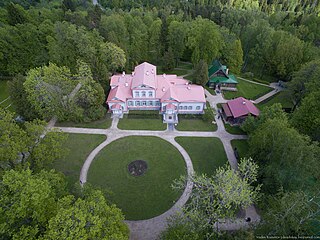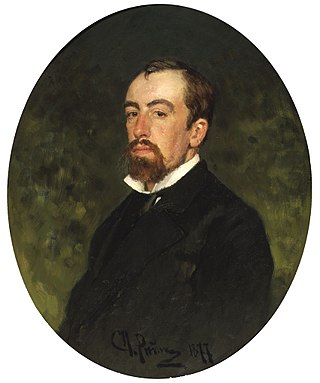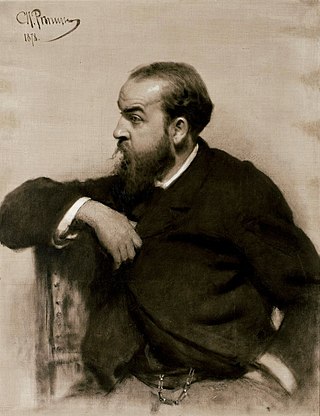
Dmitriy Vasilevich Polenov (1806-1878) was the secretary of the Imperial Russian Archaeological Society in Russia in the mid-nineteenth century. [1] His daughter was the artist Elena Dmitrievna Polenova (born Petrozavodsk in 1850). [2]

Dmitriy Vasilevich Polenov (1806-1878) was the secretary of the Imperial Russian Archaeological Society in Russia in the mid-nineteenth century. [1] His daughter was the artist Elena Dmitrievna Polenova (born Petrozavodsk in 1850). [2]

Peter I, commonly known as Peter the Great, was Tsar of all Russia from 1682, and the first Emperor of all Russia from 1721 until his death in 1725. He reigned jointly with his half-brother Ivan V until 1696. From this year, Peter was an absolute monarch, an autocrat who remained the ultimate authority and organized a well-ordered police state.

Abramtsevo is a former country estate and now museum-reserve located north of Moscow, in the proximity of Khotkovo, that became a centre for the Slavophile movement and an artists' colony in the 19th century. The estate is located in the village of Abramtsevo, in Sergiyevo-Posadsky District of Moscow Oblast. The Abramtsevo Museum-reserve site is an object of cultural heritage in Russia.

The Qajar dynasty was an Iranian dynasty founded by Mohammad Khan of the Qoyunlu clan of the Turkoman Qajar tribe.

Konstantin Petrovich Pobedonostsev was a Russian jurist and statesman who served as an adviser to three Russian emperors. During the reign of Alexander III of Russia, Pobedonostsev was considered the chief spokesman for reactionary positions and the éminence grise of imperial politics. Between 1880 and 1905, he served as Ober-Procurator of the Most Holy Synod, making him the non-clerical Russian official who supervised the Russian Orthodox Church.

Peredvizhniki, often called The Wanderers or The Itinerants in English, were a group of Russian realist artists who formed an artists' cooperative in protest of academic restrictions; it evolved into the Society for Travelling Art Exhibitions in 1870.

Vasily Dmitrievich Polenov was a Russian landscape painter associated with the Peredvizhniki movement of realist artists. His contemporaries would call him the “Knight of Beauty” as he embodied both European and Russian traditions of painting. His vision of life was summarized as following: “Art should promote happiness and joy”. As a painter and a humanist, he would truly believe in the civilizing mission of Art, Culture and Education.

Konstantin (Constantin) Alekseyevich Korovin was a leading Russian Impressionist painter.

Abram Efimovich Arkhipov was a Russian realist artist, who was a member of the art collective The Wanderers as well as the Union of Russian Artists.

Emily Shanks, also known as Emiliya Yakovlevna Shanks, was a British painter living in Moscow. She was the first woman to be elected to the Russian Society for Travelling Art Exhibitions or Peredvizhniki.

Yelena Dmitrievna Polenova was a Russian painter and graphic artist in the Art Nouveau style. She was one of the first illustrators of children's books in the Russian Empire. Her brother was the landscape painter Vasily Polenov.

Rafail Sergeevich Levitsky was a Russian and Soviet genre, romantic, and impressionist artist who was an active participant in the Peredvizhniki (Itinerant) Movement.

Polenovo is the Museum Estate of Vasily Polenov. It is situated at the high right bank of the Oka river in the Tula Region, Russia. The estate was acquired by Polenov in 1891. The white three-storied house was designed by Polenov himself. It was built in 1892.

The Moscow School of Painting, Sculpture and Architecture, also known by the acronym MUZHVZ, was one of the largest educational institutions in Russia. The school was formed by the 1865 merger of a private art college, established in Moscow in 1832, and the Palace School of Architecture, established in 1749 by Dmitry Ukhtomsky. By the end of the 19th-century, it vied with the state-run St. Petersburg Academy of Arts for the title of the largest art school in the country. In the 20th century, art and architecture separated again, into the Surikov Art Institute in Moscow and the Moscow Architectural Institute ; the latter occupies the historical School buildings in Rozhdestvenka Street.
A muftiate is an administrative territorial entity, mainly in the post-Soviet and Southeast European states, under the supervision of a mufti. In the post-Yugoslavia states, spiritual administrations similar to the muftiate are called riyasat.
Boris Alexandrovich Fogel was a Russian Empire and Soviet painter and art educator who lived and worked in Leningrad, a member of the Leningrad Union of the Soviet Artists, and a professor of painting at the Repin Institute of Arts who played an important role in the formation of the Leningrad School of Painting.

Events from the year 1861 in Russia
Rosalind Polly Blakesley is a prize-winning author, art historian and academic. She has taught art history at the University of Cambridge and been a Fellow of Pembroke College, Cambridge since 2002, and has been Professor of Russian and European Art since 2018. She previously worked at Queen's College, Oxford, the Russian Institute of Art History, Newcastle University, and the University of Kent.

Natalia Polenova is a Russian museum expert and the director of the State Memorial of History, Art and Natural Museum Reserve - Vasily Dmitrievich Polenov since 2011. She is an expert on Russian painting from the late 19th and early 20th centuries, a specialist of French culture and a member of the International Council of Museums. In 2018, she was awarded the title of Honoured Functionary of Culture of the Russian Federation in Tula.
Victoria Khiterer is associate professor of history at Millersville University, Pennsylvania, adjunct professor at Gratz College, and a founding member of the Scientific Council of the Babyn Yar Holocaust Memorial Center in Kyiv, Ukraine.

{{infobox museum | name = Mikhail Kroshitsky Sevastopol Art Museum | image = Севастопольский художественный музей им. М.П. Крошицкого 06.JPG | established = November 1927
You can help expand this article with text translated from the corresponding article in Russian. (May 2018)Click [show] for important translation instructions.
|